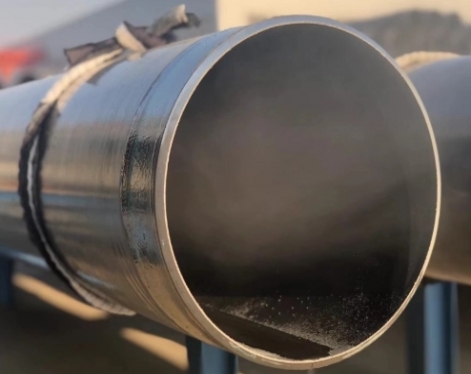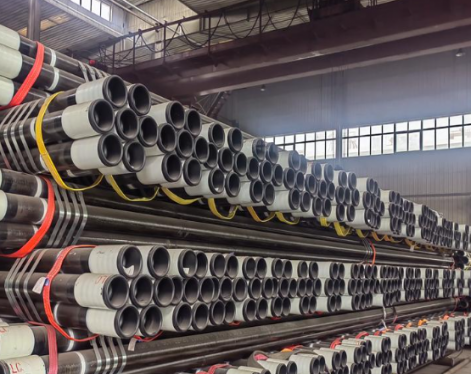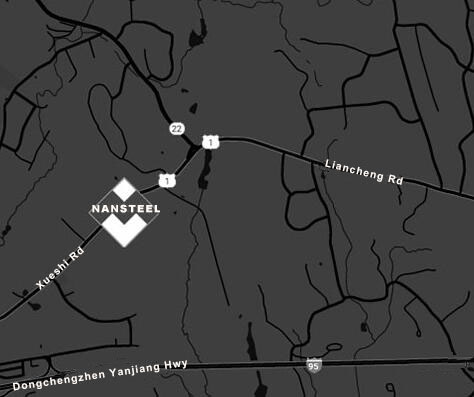The "hardest" seamless steel pipe depends on the performance aspect of the term "hardness" and the conditions under which it is used. Generally, the hardness of a steel pipe is closely related to its strength and wear resistance, but may sacrifice some toughness. Nansteel Manufacturing Co., Ltd has carefully summarized the main factors affecting the hardness of seamless steel pipe and which type of steel pipe is generally considered the "hardest."
1. Carbon content
High Carbon Steel: The hardness of steel is primarily determined by its carbon content. The higher the carbon content, the harder the steel generally is. High carbon steel typically has a carbon content between 0.6% and 2.0%. With proper heat treatment (such as quenching), high carbon steel can achieve very high hardness and is commonly used in the manufacture of tools and high-wear components.
Advantages: High hardness, high strength, and excellent wear resistance.
Disadvantages: Increased brittleness, decreased plasticity and toughness, and poor weldability.
2. Alloying Elements
Adding certain alloying elements to steel can significantly increase its hardness:
Chromium (Cr): Improves hardenability, hardness, and wear resistance.
Molybdenum (Mo): Improves strength, wear resistance, and hardenability.
Vanadium (V): Forms hard carbides, increasing hardness and wear resistance.
Tungsten (W): Improves high-temperature hardness and wear resistance.
Manganese (Mn): Improves hardenability and strength.
Steels such as tool steel contain large amounts of these alloying elements and achieve extremely high hardness through heat treatment. However, these steels are rarely made into large-scale seamless pipes for pipeline transportation and are more commonly used in the manufacture of molds, cutting tools, and other applications.
3. Heat Treatment Process
Heat treatment is a key method for increasing steel hardness:
Quenching: Heating steel to the austenitizing temperature and then rapidly cooling it creates a hard structure like martensite within the steel, significantly increasing its hardness.
Tempering: Quenched steel is often too hard and brittle, requiring tempering to improve toughness while maintaining a high hardness.
Surface quenching (such as high-frequency quenching)/carburizing: For components requiring high surface hardness while maintaining core toughness, surface quenching or carburizing (increasing the surface carbon content before quenching) can be performed to achieve a surface hardness of HRC 55-62 or even higher.

Which seamless steel pipe is the hardest?
Strictly speaking, the "seamless steel pipe" used for pipeline transportation pursues comprehensive performance, that is, while meeting sufficient strength and pressure-bearing capacity, it must also have certain toughness, weldability and corrosion resistance. Extremely high hardness often means increased brittleness, which is dangerous in pipeline applications.
However, if we only look at the "hardness" indicator, usually:
High carbon alloy seamless steel pipes undergo special heat treatment: For example, seamless steel pipes made of certain high carbon alloy structural steels (such as 45CrMo, 440C stainless steel, etc.) can obtain very high hardness through heat treatment processes such as quenching + low temperature tempering. These pipes may be used for specific mechanical parts, such as high wear-resistant sleeves, bearing bushings or hydraulic cylinders, rather than for fluid transportation.
Special wear-resistant seamless steel pipe: Pipes used to transport media such as slurry, coal powder, and abrasives will be made of alloy steel containing high-hardness carbide phase, or surface hardening treatment (such as carburizing, nitriding, induction quenching, etc.) will be selected to improve its wear resistance and surface hardness.
Some high-strength oil drill pipes and casings: Certain high-level API drill pipe steel grades (such as S135) and casing steel grades (such as Q125) have high hardness to resist wear and deformation while ensuring high strength, but their hardness is usually controlled within a certain range to ensure sufficient toughness and resistance to stress corrosion cracking.
Please note: Common carbon steel seamless pipes such as ASTM A106 Gr.B and API 5L, as well as low-alloy steel pipes such as P11 and P22 used for boilers, are primarily designed for strength, toughness, and resistance to high temperature and high pressure, rather than extreme hardness. Excessive hardness will increase brittleness and reduce safety margins in these applications.
Conclusion
There is no single “hardest” seamless steel pipe, as hardness often comes with brittleness. If you are looking for wear resistance in pipes or high surface hardness required for specific mechanical components, then you need to look for:
Steel grades with higher carbon contents;
Steel grades containing alloying elements that form hard carbides;
Seamless steel pipes that have been quenched, tempered, or case-hardened.
In practical applications, steel pipe selection requires a comprehensive consideration of hardness, strength, toughness, corrosion resistance, and cost to find the material best suited for specific operating conditions.
Read more: Seamless Steel Pipe for Geological Use
1. Carbon content
High Carbon Steel: The hardness of steel is primarily determined by its carbon content. The higher the carbon content, the harder the steel generally is. High carbon steel typically has a carbon content between 0.6% and 2.0%. With proper heat treatment (such as quenching), high carbon steel can achieve very high hardness and is commonly used in the manufacture of tools and high-wear components.
Advantages: High hardness, high strength, and excellent wear resistance.
Disadvantages: Increased brittleness, decreased plasticity and toughness, and poor weldability.
2. Alloying Elements
Adding certain alloying elements to steel can significantly increase its hardness:
Chromium (Cr): Improves hardenability, hardness, and wear resistance.
Molybdenum (Mo): Improves strength, wear resistance, and hardenability.
Vanadium (V): Forms hard carbides, increasing hardness and wear resistance.
Tungsten (W): Improves high-temperature hardness and wear resistance.
Manganese (Mn): Improves hardenability and strength.
Steels such as tool steel contain large amounts of these alloying elements and achieve extremely high hardness through heat treatment. However, these steels are rarely made into large-scale seamless pipes for pipeline transportation and are more commonly used in the manufacture of molds, cutting tools, and other applications.
3. Heat Treatment Process
Heat treatment is a key method for increasing steel hardness:
Quenching: Heating steel to the austenitizing temperature and then rapidly cooling it creates a hard structure like martensite within the steel, significantly increasing its hardness.
Tempering: Quenched steel is often too hard and brittle, requiring tempering to improve toughness while maintaining a high hardness.
Surface quenching (such as high-frequency quenching)/carburizing: For components requiring high surface hardness while maintaining core toughness, surface quenching or carburizing (increasing the surface carbon content before quenching) can be performed to achieve a surface hardness of HRC 55-62 or even higher.

Which seamless steel pipe is the hardest?
Strictly speaking, the "seamless steel pipe" used for pipeline transportation pursues comprehensive performance, that is, while meeting sufficient strength and pressure-bearing capacity, it must also have certain toughness, weldability and corrosion resistance. Extremely high hardness often means increased brittleness, which is dangerous in pipeline applications.
However, if we only look at the "hardness" indicator, usually:
High carbon alloy seamless steel pipes undergo special heat treatment: For example, seamless steel pipes made of certain high carbon alloy structural steels (such as 45CrMo, 440C stainless steel, etc.) can obtain very high hardness through heat treatment processes such as quenching + low temperature tempering. These pipes may be used for specific mechanical parts, such as high wear-resistant sleeves, bearing bushings or hydraulic cylinders, rather than for fluid transportation.
Special wear-resistant seamless steel pipe: Pipes used to transport media such as slurry, coal powder, and abrasives will be made of alloy steel containing high-hardness carbide phase, or surface hardening treatment (such as carburizing, nitriding, induction quenching, etc.) will be selected to improve its wear resistance and surface hardness.
Some high-strength oil drill pipes and casings: Certain high-level API drill pipe steel grades (such as S135) and casing steel grades (such as Q125) have high hardness to resist wear and deformation while ensuring high strength, but their hardness is usually controlled within a certain range to ensure sufficient toughness and resistance to stress corrosion cracking.
Please note: Common carbon steel seamless pipes such as ASTM A106 Gr.B and API 5L, as well as low-alloy steel pipes such as P11 and P22 used for boilers, are primarily designed for strength, toughness, and resistance to high temperature and high pressure, rather than extreme hardness. Excessive hardness will increase brittleness and reduce safety margins in these applications.
Conclusion
There is no single “hardest” seamless steel pipe, as hardness often comes with brittleness. If you are looking for wear resistance in pipes or high surface hardness required for specific mechanical components, then you need to look for:
Steel grades with higher carbon contents;
Steel grades containing alloying elements that form hard carbides;
Seamless steel pipes that have been quenched, tempered, or case-hardened.
In practical applications, steel pipe selection requires a comprehensive consideration of hardness, strength, toughness, corrosion resistance, and cost to find the material best suited for specific operating conditions.
Read more: Seamless Steel Pipe for Geological Use









